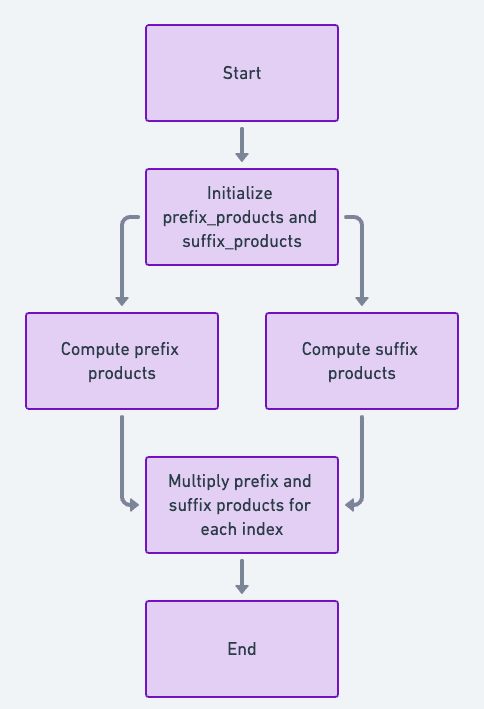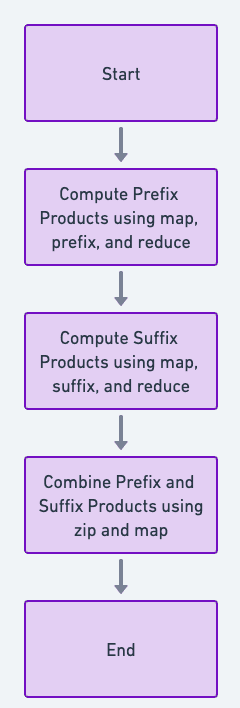Problem 1 wasn't too bad, so on to Problem 2. Here's the prompt
❓ PROMPT
Given an array of integers, return a new array such that each element at index i of the new array is the product of all the numbers in the original array except the one at i.
For example, if our input was [1, 2, 3, 4, 5], the expected output would be [120, 60, 40, 30, 24]. If our input was [3, 2, 1], the expected output would be [2, 3, 6].
Follow-up: what if you can't use division?
🔍 EXPLORE
Assumptions
- The input array will have at least two integers (because if it has only one, the problem doesn't make sense).
- The integers can be positive, negative, or zero.
Discoveries
- If the array contains two or more zeros, the result for all positions will be zero.
- If the array contains one zero, all positions except the zero will be zero, and the position with the zero will be the product of all other numbers.
Edge/Corner Cases
- Array with all zeros.
- Array with one zero and other numbers.
- Array with negative numbers.
- Array with all ones.
🗣️ CLARIFYING QUESTIONS
The challenge seems pretty clear to me. However, I'd love to know if there's a limit on the size of the array or the range of the integers. But for now, let's proceed with the given information.
💡 BRAINSTORM
- Brute Force Approach: For each index
i, compute the product of all elements excepti. This would take O(n2) time. - Division Approach: Compute the product of all elements and then for each index
i, divide the total product by the element ati. This is O(n) time but uses division. - Prefix and Suffix Product Approach (without division): For each element at index
i, compute the product of elements beforeiand the product of elements afteri. This is O(n) time and doesn't use division.
Considering the follow-up question, I'll opt for the third approach as our "master plan" since it's efficient and doesn't use division.
- Time Complexity: O(n)
- Space Complexity: O(n) (for storing prefix and suffix products)
📝 PLAN
- Create two arrays,
prefix_productsandsuffix_products. - For
prefix_products, go through the input array and compute the product of all elements before each index. - For
suffix_products, go through the input array in reverse and compute the product of all elements after each index. - For the result, multiply the prefix and suffix products for each index.
Initialize an empty array called prefix_products
Initialize an empty array called suffix_products
For each index i in the input array:
Calculate the product of all elements before index i and store it in prefix_products[i]
End of loop
For each index i in the input array, starting from the end:
Calculate the product of all elements after index i and store it in suffix_products[i]
End of loop
Initialize an empty array called result
For each index i in the input array:
result[i] = prefix_products[i] * suffix_products[i]
End of loop
Return result🖍️ DIAGRAM
🛠️ IMPLEMENT
func productExceptSelf(_ nums: [Int]) -> [Int] {
let n = nums.count
var prefix_products = [Int](repeating: 1, count: n)
var suffix_products = [Int](repeating: 1, count: n)
var result = [Int](repeating: 1, count: n)
// Compute prefix products
for i in 1..<n {
prefix_products[i] = prefix_products[i - 1] * nums[i - 1]
}
// Compute suffix products
for i in stride(from: n - 2, through: 0, by: -1) {
suffix_products[i] = suffix_products[i + 1] * nums[i + 1]
}
// Compute result
for i in 0..<n {
result[i] = prefix_products[i] * suffix_products[i]
}
return result
}🧪 VERIFY
Let's test our code with the provided examples and some additional ones:
- Standard Case: An array with no zeros and positive numbers.
- Input:
[1, 2, 3, 4, 5]-> Output:[120, 60, 40, 30, 24]
- Input:
- Smaller Array: A smaller array to test the basic functionality.
- Input:
[3, 2, 1]-> Output:[2, 3, 6]
- Input:
- Array with a Zero: This will test if the function handles zeros correctly.
- Input:
[0, 1, 2, 3, 4]-> Output:[24, 0, 0, 0, 0]
- Input:
- Array with Negative Numbers: To ensure the function can handle negative numbers.
- Input:
[-1, 2, -3, 4, -5]-> Output:[120, -60, 40, -30, 24]
- Input:
🔄 REVIEW AND REFACTOR
Alright, after reviewing the code, here are some thoughts:
- Readability: The code is quite readable with clear variable names and inline comments explaining the logic.
- Efficiency: The solution is efficient with a time complexity of O(n) and space complexity of O(n). Given the problem constraints, this is optimal.
- Swift Best Practices: The code adheres to Swift's best practices. The use of stride for reverse iteration is a nice touch.
There doesn't seem to be a need for refactoring at this point. The code is clean, efficient, and adheres to best practices, but it'd be interesting to see what a functional approach would look like.
💡 BRAINSTORM
Functional programming emphasizes immutability, higher-order functions, and the use of functions to transform data. Given this, here are some potential functional approaches:
- Higher-Order Functions: Use Swift's built-in functions like
map,reduce,prefix, andsuffixto compute the products without explicit loops. - Immutable Data: Avoid any mutable state or variables. Instead, focus on transforming data from one form to another.
- Combine Prefix and Suffix Products: Use the
zipfunction to combine prefix and suffix products and compute the final result.
📝 PLAN
-
Compute Prefix Products:
- Use the
mapfunction to iterate over each index of the input array. - For each index
i, use theprefixfunction to get all elements beforei. - Use the
reducefunction to compute the product of these elements.
- Use the
-
Compute Suffix Products:
- Similarly, use the
mapfunction to iterate over each index. - For each index
i, use thesuffixfunction to get all elements afteri. - Use
reduceto compute the product of these elements.
- Similarly, use the
-
Combine Prefix and Suffix Products:
- Use the
zipfunction to combine the prefix and suffix products for each index. - Use
mapto multiply the prefix and suffix products for each index to get the final result.
- Use the
🖍️ DIAGRAM
🛠️ IMPLEMENT
func productExceptSelf(_ nums: [Int]) -> [Int] {
// Compute prefix products using reduce
let prefix_products = nums.indices.map { i in
nums.prefix(i).reduce(1, *)
}
// Compute suffix products using reverse and reduce
let suffix_products = nums.indices.map { i in
nums.suffix(from: i + 1).reduce(1, *)
}
// Combine prefix and suffix products
return zip(prefix_products, suffix_products).map { $0 * $1 }
}📊 ANALYZE
Time Complexity: - Imperitiave O(n) - We iterate through the array three times, but the complexity remains linear - Functional O(n2) - This is because for each element, we're computing the product of elements before and after it using prefix and suffix.
Space Complexity:
- Both O(n) - We're creating new arrays for prefix and suffix products.
Limitations: - Imperative: The space complexity could be reduced to O(1) if we modify the input array in place, but that would make the code less intuitive. - Functional: While elegant, is less efficient than the previous approach. It's more suited for smaller arrays or situations where performance isn't a top priority.
Potential Improvements:
If space optimization is a priority, we could compute the result in place by first calculating the prefix products in the result array and then using a single variable to keep track of the suffix product as we iterate in reverse to compute the final result. But I think a hybrid approach could be considered, where we use functional programming concepts but also leverage some iterative methods to improve efficiency.
func productExceptSelf(_ nums: [Int]) -> [Int] {
let prefix_products = computePrefixProducts(nums)
let suffix_products = computeSuffixProducts(nums)
return zip(prefix_products, suffix_products).map { $0 * $1 }
}
private func computePrefixProducts(_ nums: [Int]) -> [Int] {
let n = nums.count
var prefix_products = [Int](repeating: 1, count: n)
for i in 1..<n {
prefix_products[i] = prefix_products[i - 1] * nums[i - 1]
}
return prefix_products
}
private func computeSuffixProducts(_ nums: [Int]) -> [Int] {
let n = nums.count
var suffix_products = [Int](repeating: 1, count: n)
for i in stride(from: n - 2, through: 0, by: -1) {
suffix_products[i] = suffix_products[i + 1] * nums[i + 1]
}
return suffix_products
}💭 Similar Questions
This question is reminiscent of a common interview question that tests the candidate's ability to think about array manipulations without resorting to the obvious division approach. Here's a link to a similar question on LeetCode: Product of Array Except Self
Final Thoughts
Well, here we are again, diving headfirst into another algorithmic rabbit hole. And what did we find? Two approaches, both with their own quirks and "charms".
Imperative Approach: Ah, the good old step-by-step method. It's like following a recipe, only to realize you've been making a sandwich the whole time. Sure, it's efficient and gets the job done. And while it's optimal in terms of time, it's a bit of a space hog. But hey, who needs memory efficiency when you can just buy more RAM, right?
Functional Approach: Now, this was a trip. It's like trying to read Shakespeare when all you wanted was a simple story. Elegant? Sure. Concise? Absolutely. But at the cost of efficiency. It's like buying a sports car and then realizing it's got the engine of a lawnmower. But hey, at least it looks good on the driveway.
And then there's the thought of mixing both styles. It's like trying to mix oil and water, hoping for a delicious cocktail. But, surprisingly, it might just be the best balance. It's got the clarity of the imperative approach and the elegance of the functional one. It's like having your cake and eating it too, only to realize it's calorie-free. A win-win, if you ask me.
The problem itself? Classic. It's one of those "gotcha" questions where the obvious solution is, well, not the best one. Nested loops? Division? Those are for amateurs. But with a bit of (a lot of) head-scratching, we can find something that works. Kind of.
In the grand scheme of things, this was another exercise in humility. Algorithms have a way of making you feel like you're back in school, staring blankly at a math problem while the clock ticks away. But, as they say, practice makes... well, not perfect, but maybe less bad?
So, here's to the next problem that'll have me questioning my life choices. Until then, keep coding (or at least, try to). 🥴

